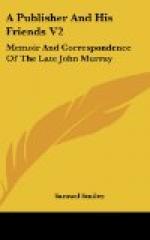CHAPTER V
ORIGIN OF THE “QUARTERLY REVIEW”
The publication of a Tory Review was not the result of a sudden inspiration. The scheme had long been pondered over. Mr. Canning had impressed upon Mr. Pitt the importance of securing the newspaper press, then almost entirely Whiggish or Revolutionary, on the side of his administration. To combat, in some measure, the democratic principles then in full swing, Mr. Canning, with others, started, in November 1797, the Anti-Jacobin, or Weekly Examiner.
The Anti-Jacobin ceased to be published in 1798, when Canning, having been appointed Under-Secretary of State for Foreign Affairs, found his time fully occupied by the business of his department, as well as by his parliamentary duties, and could no longer take part in that clever publication.
Four years later, in October 1802, the first number of the Edinburgh Review was published. It appeared at the right time, and, as the first quarterly organ of the higher criticism, evidently hit the mark at which it aimed. It was conducted by some of the cleverest literary young men in Edinburgh—Jeffrey, Brougham, Sydney Smith, Francis Horner, Dr. Thomas Brown, and others. Though Walter Scott was not a founder of the Review, he was a frequent contributor.
In its early days the criticism was rude, and wanting in delicate insight; for the most part too dictatorial, and often unfair. Thus Jeffrey could never appreciate the merits of Wordsworth, Southey, and Coleridge. “This will never do!” was the commencement of his review of Wordsworth’s noblest poem. Jeffrey boasted that he had “crushed the ‘Excursion.’” “He might as well say,” observed Southey, “that he could crush Skiddaw.” Ignorance also seems to have pervaded the article written by Brougham, in the second number of the Edinburgh, on Dr. Thomas Young’s discovery of the true principles of interferences in the undulatory theory of light. Sir John Herschell, a more competent authority, said of Young’s discovery, that it was sufficient of itself to have placed its author in the highest rank of scientific immortality.
The situation seemed to Mr. Murray to warrant the following letter:
John Murray to the Right Hon. George Canning.
September 25, 1807.
Sir,
I venture to address you upon a subject that is not, perhaps, undeserving of one moment of your attention. There is a work entitled the Edinburgh Review, written with such unquestionable talent that it has already attained an extent of circulation not equalled by any similar publication. The principles of this work are, however, so radically bad that I have been led to consider the effect that such sentiments, so generally diffused, are likely to produce, and to think that some means equally popular ought to be adopted to counteract their dangerous tendency.




